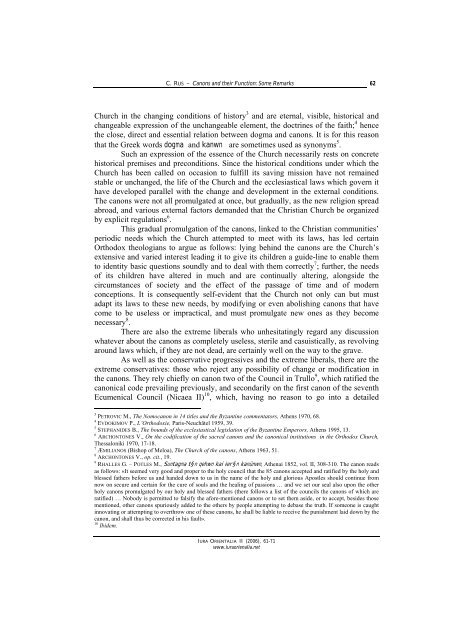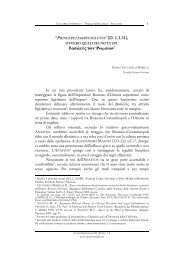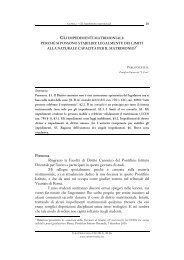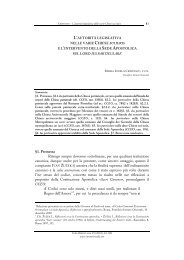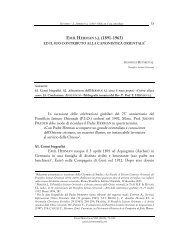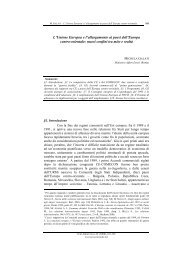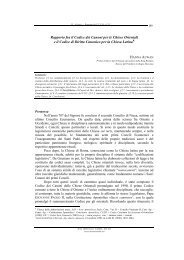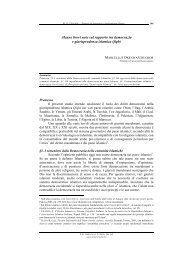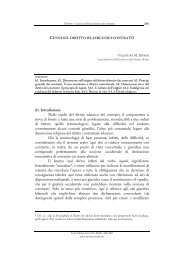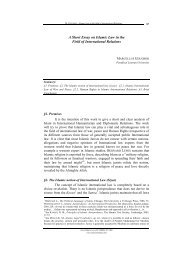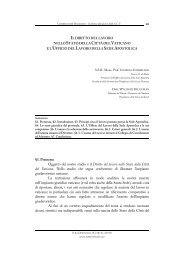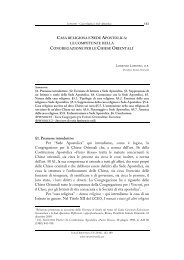The Canons of the Church and their ecclesiastical ... - iura orientalia
The Canons of the Church and their ecclesiastical ... - iura orientalia
The Canons of the Church and their ecclesiastical ... - iura orientalia
Create successful ePaper yourself
Turn your PDF publications into a flip-book with our unique Google optimized e-Paper software.
C. RUS – <strong>Canons</strong> <strong>and</strong> <strong>the</strong>ir Function: Some Remarks62<strong>Church</strong> in <strong>the</strong> changing conditions <strong>of</strong> history 3 <strong>and</strong> are eternal, visible, historical <strong>and</strong>changeable expression <strong>of</strong> <strong>the</strong> unchangeable element, <strong>the</strong> doctrines <strong>of</strong> <strong>the</strong> faith; 4 hence<strong>the</strong> close, direct <strong>and</strong> essential relation between dogma <strong>and</strong> canons. It is for this reasonthat <strong>the</strong> Greek words dovgma <strong>and</strong> kavnwn are sometimes used as synonyms 5 .Such an expression <strong>of</strong> <strong>the</strong> essence <strong>of</strong> <strong>the</strong> <strong>Church</strong> necessarily rests on concretehistorical premises <strong>and</strong> preconditions. Since <strong>the</strong> historical conditions under which <strong>the</strong><strong>Church</strong> has been called on occasion to fulfill its saving mission have not remainedstable or unchanged, <strong>the</strong> life <strong>of</strong> <strong>the</strong> <strong>Church</strong> <strong>and</strong> <strong>the</strong> <strong>ecclesiastical</strong> laws which govern ithave developed parallel with <strong>the</strong> change <strong>and</strong> development in <strong>the</strong> external conditions.<strong>The</strong> canons were not all promulgated at once, but gradually, as <strong>the</strong> new religion spreadabroad, <strong>and</strong> various external factors dem<strong>and</strong>ed that <strong>the</strong> Christian <strong>Church</strong> be organizedby explicit regulations 6 .This gradual promulgation <strong>of</strong> <strong>the</strong> canons, linked to <strong>the</strong> Christian communities’periodic needs which <strong>the</strong> <strong>Church</strong> attempted to meet with its laws, has led certainOrthodox <strong>the</strong>ologians to argue as follows: lying behind <strong>the</strong> canons are <strong>the</strong> <strong>Church</strong>’sextensive <strong>and</strong> varied interest leading it to give its children a guide-line to enable <strong>the</strong>mto identity basic questions soundly <strong>and</strong> to deal with <strong>the</strong>m correctly 7 ; fur<strong>the</strong>r, <strong>the</strong> needs<strong>of</strong> its children have altered in much <strong>and</strong> are continually altering, alongside <strong>the</strong>circumstances <strong>of</strong> society <strong>and</strong> <strong>the</strong> effect <strong>of</strong> <strong>the</strong> passage <strong>of</strong> time <strong>and</strong> <strong>of</strong> modernconceptions. It is consequently self-evident that <strong>the</strong> <strong>Church</strong> not only can but mustadapt its laws to <strong>the</strong>se new needs, by modifying or even abolishing canons that havecome to be useless or impractical, <strong>and</strong> must promulgate new ones as <strong>the</strong>y becomenecessary 8 .<strong>The</strong>re are also <strong>the</strong> extreme liberals who unhesitatingly regard any discussionwhatever about <strong>the</strong> canons as completely useless, sterile <strong>and</strong> casuistically, as revolvingaround laws which, if <strong>the</strong>y are not dead, are certainly well on <strong>the</strong> way to <strong>the</strong> grave.As well as <strong>the</strong> conservative progressives <strong>and</strong> <strong>the</strong> extreme liberals, <strong>the</strong>re are <strong>the</strong>extreme conservatives: those who reject any possibility <strong>of</strong> change or modification in<strong>the</strong> canons. <strong>The</strong>y rely chiefly on canon two <strong>of</strong> <strong>the</strong> Council in Trullo 9 , which ratified <strong>the</strong>canonical code prevailing previously, <strong>and</strong> secondarily on <strong>the</strong> first canon <strong>of</strong> <strong>the</strong> seventhEcumenical Council (Nicaea II) 10 , which, having no reason to go into a detailed3 PETROVIC M., <strong>The</strong> Nomocanon in 14 titles <strong>and</strong> <strong>the</strong> Byzantine commentators, A<strong>the</strong>ns 1970, 68.4 EVDOKIMOV P., L’Orthodoxie, Paris-Neuchâtel 1959, 39.5 STEPHANIDES B., <strong>The</strong> bounds <strong>of</strong> <strong>the</strong> <strong>ecclesiastical</strong> legislation <strong>of</strong> <strong>the</strong> Byzantine Emperors, A<strong>the</strong>ns 1995, 13.6 ARCHONTONES V., On <strong>the</strong> codification <strong>of</strong> <strong>the</strong> sacred canons <strong>and</strong> <strong>the</strong> canonical institutions in <strong>the</strong> Orthodox <strong>Church</strong>,<strong>The</strong>ssaloniki 1970, 17-18.7 ÆMILIANOS (Bishop <strong>of</strong> Meloa), <strong>The</strong> <strong>Church</strong> <strong>of</strong> <strong>the</strong> canons, A<strong>the</strong>ns 1963, 51.8 ARCHONTONES V., op. cit., 19.9 RHALLES G. – POTLES M., Suvntagma t§n qeh=wn kaiV èer§n kanünwn, A<strong>the</strong>nai 1852, vol. II, 308-310. <strong>The</strong> canon readsas follows: «It seemed very good <strong>and</strong> proper to <strong>the</strong> holy council that <strong>the</strong> 85 canons accepted <strong>and</strong> ratified by <strong>the</strong> holy <strong>and</strong>blessed fa<strong>the</strong>rs before us <strong>and</strong> h<strong>and</strong>ed down to us in <strong>the</strong> name <strong>of</strong> <strong>the</strong> holy <strong>and</strong> glorious Apostles should continue fromnow on secure <strong>and</strong> certain for <strong>the</strong> cure <strong>of</strong> souls <strong>and</strong> <strong>the</strong> healing <strong>of</strong> passions … <strong>and</strong> we set our seal also upon <strong>the</strong> o<strong>the</strong>rholy canons promulgated by our holy <strong>and</strong> blessed fa<strong>the</strong>rs (<strong>the</strong>re follows a list <strong>of</strong> <strong>the</strong> councils <strong>the</strong> canons <strong>of</strong> which areratified) … Nobody is permitted to falsify <strong>the</strong> afore-mentioned canons or to set <strong>the</strong>m aside, or to accept, besides thosementioned, o<strong>the</strong>r canons spuriously added to <strong>the</strong> o<strong>the</strong>rs by people attempting to debase <strong>the</strong> truth. If someone is caughtinnovating or attempting to overthrow one <strong>of</strong> <strong>the</strong>se canons, he shall be liable to receive <strong>the</strong> punishment laid down by <strong>the</strong>canon, <strong>and</strong> shall thus be corrected in his fault».10 Ibidem.IURA ORIENTALIA II (2006), 61-71www.<strong>iura</strong>orienalia.net


